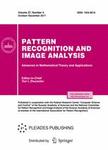版权所有:内蒙古大学图书馆 技术提供:维普资讯• 智图
内蒙古自治区呼和浩特市赛罕区大学西街235号 邮编: 010021

作者机构:National Research University of Electronic Technology Zelenograd Russia Federal Research Center Computer Science and Control of Russian Academy of Sciences Moscow Russia Moscow Institute of Physics and Technology Dolgoprudnyi Russia
出 版 物:《Pattern Recognition and Image Analysis》 (Pattern Recogn. Image Anal.)
年 卷 期:2018年第28卷第4期
页 面:652-657页
核心收录:
学科分类:0710[理学-生物学] 1205[管理学-图书情报与档案管理] 08[工学] 0835[工学-软件工程] 0836[工学-生物工程] 0812[工学-计算机科学与技术(可授工学、理学学位)]
基 金:The article is published in the original. Mikhail V. Korobkin received the B.S. and M.S. degrees (with honours) in Computer Science and Engineering from the National Research University of Electronic Technology (MIET) Moscow in 2013 where he is currently a candidate for the PhD degree. Mr. Korobkin is the author of more than 10 articles and 4 inventions. His research interests include computer vision machine learning robotics and automation. Gleb A. Odinokikh obtained his MSc degree in Bioengineering Systems and Technologies from Bauman Moscow State Technical University. He is currently a PhD student at the Federal Research Center "Computer Science and Control" of RAS and research engineer at Samsung R&D Institute Russia. He is the author of several inventions and research works in the field of mobile biometrics which is the focus of his current research. Yurii S. Efimov received the BSc and MSc degree at Moscow Institute of Physics and Technology (MIPT) in 2018. He is currently a PhD student at Moscow Institute of Physics and Technology and a research engineer at Samsung R&D Institute Russia. He is the author of several research works in the field of iris recognition. Research insterests: computer vision and machine learning. Ivan A. Solomatin received his BSc and MSc degree (with honour) in Applied Mathematics from Moscow Institute of Physics and Technology (MIPT) in 2018. He is currently a PhD student at Moscow Institute of Physics and Technology and a research engineer at Samsung R&D Institute Russia. He is the author of several articles in the field of iris recognition which is the focus of his current research. Ivan A. Matveev received the MSc degree at the Moscow Institute of Physics and Technology in 1997 Ph.D. in 1999 and Dr. Sci. in 2014 from Computing Centre of Russian Academy of Sciences. Since 2004 he runs Intellectual Systems sector of the Complex Systems department at Computing Centre of Russian Academy of Sciences. Research interests: biometric identification face and iris recognition realtime image processing
摘 要:Iris segmentation is an irreplaceable stage of iris recognition pipeline. Its quality hugely affects overall accuracy. Previously when conditions were mild and controlled the task was solved by image processing techniques and rule based approaches. Nowadays widespread of biometric technologies has relaxed operation conditions for such systems demanding more flexible and robust solutions. Constantly increasing data and sensors availability created fertile field for growth of machine learning methods capable to cope with complex conditions. The latest contributions to iris segmentation were made on this surge by leveraging abundant data and modern machine learning algorithms. In spite of previously achieved great results this work addresses even more challenging conditions that allows iris recognition to be used in wide range of real life cases. Novel CNN architectures are proposed in this work. They were designed to combine the latest achievements in classification and semantic segmentation fields. FCN and SegNet architectures have been picked up as prototypes and were strengthened by residual blocks. This allowed to make lightweight networks that could be shipped on various embedded platforms to successfully operate under less controllable environmental conditions. The approach allowed to obtain 0.93 and 0.92 IoU on original and modified CASIA-Iris-Lamp datasets which is a significant improvement in comparison with the results achieved before. © 2018, Pleiades Publishing, Ltd.